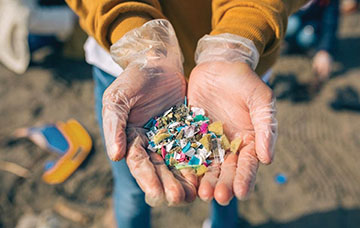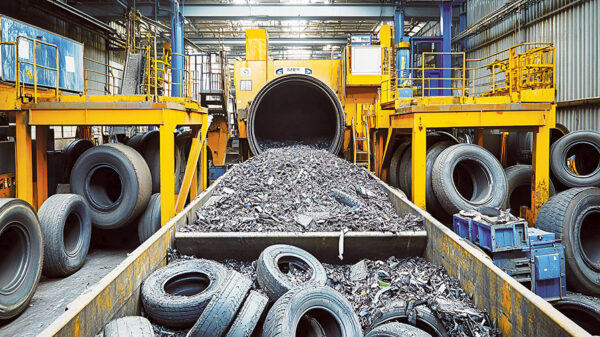by MAURA KELLER
mkeller@americanrecycler.com
The distribution, size and quantity of microplastics in the environment and the recently discovered health risks are propelling microplastics (MPs) to the forefront of industrial, environmental and health concerns. These tiny but powerful elements are also capturing the attention of the plastics recycling industry like never before.
Microplastics are small fragments of any type of plastic and are defined according to the U.S. National Oceanic and Atmospheric Administration as “less than 5mm in length.”

Recently discovered health risks are propelling microplastics to the forefront of industrial, environmental and health concerns.
According to Ryan McManus, government affairs manager at the American Public Works Association (APWA), an organization providing a voice for all public works industries across public and private sectors, microplastics are getting more scrutiny because of the sharp rise in plastic production in the past century and the increased impact on the environment and risk to human health. Additionally, McManus said they have attracted concern given their relationships with other “emerging contaminants” like Per- and Polyfluoroalkyl Substances (PFAS), which can occur as microplastics and are used as a coating on plastics that then break down concurrently. Non-PFAS microplastics can also involve PFAS at certain stages in their production process.
“PFAS are synthetic chemical compounds used in a variety of industrial and consumer product applications, found in water, air, fish and soil that can contaminate locations across the globe,” McManus said. “They are harmful to humans in small doses and have been attributed to several health issues including cancer, low infant birth weights, immune disorders and thyroid hormone disruption. And as the APWA recognizes, the presence of PFA compounds in source water and drinking water is of increasing public concern due to their widespread use and environmental persistence.”
Companies and organizations like the APWA – a non-for-profit, international association that serves more than 30,000 members of those who work in the field of public works – have been trying to address the issue of microplastics through research, reducing use of plastics and improvements in recycling to ensure less plastic waste ends up in the environment. In some cases, businesses have changed materials entirely for packaging, such as when fast-food restaurants ceased using foam containers.
According to Alexander Tompkins, chief executive officer and co-founder of Microplastic Free Systems and Safety, a biotechnology start up based in Rhode Island, microplastics are the result of plastic degradation.
“Plastic does not biodegrade, rather it erodes and fragments into smaller pieces, ranging in size from five millimeters to one micron. The natural forces that initiate this process include heat, UV radiation, wind action, ocean currents, and other physical stressors,” Tompkins said.
Microplastic pollution has been found in every corner of the world – from the snow on Mt. Everest to seawater in the Marianas Trench. In Tompkins’ state of Rhode Island, a 2019 study concluded there are upwards of 4.6 million individual pieces of plastic in 100 grams of Narragansett Bay sediment.
The Largest Concerns
The three concerns surrounding microplastics are their carcinogenic chemical makeup, potential for increased pollution, and the need for physical removal. As Tompkins explained, microplastics can absorb, hold, and deposit toxic substances into the body.
“Our food and water supply is saturated with plastic pollution. A study from the University of Vienna found that five grams of plastic, the weight of a credit card, passes through the human gastrointestinal tract a week. The digestive processes the microplastics are subjected to cause them to expel the chemicals they carry,” Tompkins said.
With 8.3 billion metric tons of plastic created since the 1950s, Tompkins said we are only beginning to observe the effects of plastic degradation into microplastics. The total amount of plastic produced has yet to fully degrade.
“What we are currently observing is what has broken down in the past 70 years. This suggests an exponential increase in microplastics pollution as more plastic breaks down,” Tompkins said.
Unlike biodegradable waste, plastic cannot return to the earth to be used again. Over millions of years, the plastic waste will become a synthetic oil. Tompkins said this is the third major concern with microplastic pollution.
“To have any measurable impact on microplastics pollution in our time, we must physically remove microplastics from our food and water supply, as well as the environment at large,” he said.
The Great Unknown
John Scott, senior chemist, The Illinois Sustainable Technology Center at the Prairie Research Institute, pointed out that there are a tremendous amount of “unknowns” related to microplastics.
“But here is what we do know. Every year, we produce a lot of plastics. I mean…really a lot. Last time I checked, globally we were making north of 550 million metric tons every year. Also concerning is that it’s not slowing down. Just the opposite, it increases every year,” Scott said. “The last projection I read was that we will in the billions of metric tons annually by the year 2050. So where is all this plastic going to go? Well the vast majority will end up in the environment (via landfills or become fugitive). It is not going away anytime soon. It’s just going to break down to smaller and smaller sizes over time. Also note, as these plastics get smaller, they become more mobile in the environment, have a greater potential to cross biological membranes, and are more difficult/costly to remediate. Consider this as well….even if we stop using plastic cold turkey today…we will still have legacy plastics around for hundreds of years to come.”
And while we don’t know the adverse effects resulting from microplastic exposure, Scott believes the story is much more complex than just plastic alone. Plastics are extremely complex materials. As he explained, we have thousands of different polymer types and to make it even more complex, most materials are a mixture of polymers.
“What I think is alarming, are the additives used in plastics. There are well over 10,000 different chemicals that can potentially be used with plastics. Many of these chemicals are either known or suspected carcinogens, endocrine disrupters, and so on,” Scott said. “Also we know that plastic in the environment can soak up pollutants from their surrounding environment and we know that they can harbor/promote biological materials (microbes) that are much different than the surrounding environment. So, can they be a vector for chemical pollutants and biological materials?”
The Role of Plastic Recycling
Scott does not believe there will be a single “silver bullet” that will solve the microplastic problem, but he does believe the recycling industry can have a major impact in this area.
“I firmly believe that we will soon see dramatic innovations and new technologies in this industry that will make them more efficient and capable to handle more diverse materials. Recycling rates of plastic is quite low, around 8 percent I believe, and this leaves much room for improvement,” Scott said. “Recycling already has great infrastructure and it has already overcame many of the huddles associated with behavior change. People know recycling and willing to do it. If the recycling industry can find new ways to handle materials contaminated (with things such as food or additives) and find ways to deal with multi-layered and multi-component plastics, then they can hopefully drive down the current production rates of plastic and reduce the amount of environment contamination.”
Of course, there has been a tremendous effort to use recycled plastic packaging or plastic free alternative packaging. Tompkins pointed out that though it is a great way to repurpose plastic after a single use, recycled plastic packaging doesn’t remove the plastic waste from the economy or environment, it transfers the pollution to another product.
“The issue with plastic free alternative packaging is the hidden plastics and chemicals within the packaging. For example, corrugated cardboard boxes have a plastic film on the interior, and glass bottles have a plastic film on the bottle cap,” Tompkins said.
For recyclers handling plastic recycling, the focus on microplastics will continue to put more pressure on the industry to improve on reduction, reuse and development of, or shift, to more biodegradable and less toxic forms of plastic.
“Attention should be paid to potential regulatory efforts on the federal level, but also across different states and localities where some governments may be pursuing more aggressive measures,” McManus said. “Some laws that are seen as successful in achieving these goals may be mimicked by other states in some cases, before their effectiveness may even be fully determined.”
One of the biggest challenges facing the plastics recycling industry as it relates to microplastics is ironically, their small size.
“Recycling plastic means processing, which means potentially the release of microplastics in that process. This may make recycling self-defeating, particularly if not done carefully,” McManus said.
Tompkins suggested that to fully address the issue of microplastics in packaging, companies should commit to entirely plastic free packaging, such as hemp fibers stretched into plastic-like films, burlap bags for groceries, and glass bottles without the plastic film. Once plastic packaging is a thing of the past, the removal of microplastic will be possible.
Of course, how the microplastics issue will continue to evolve within the plastics recycling space will depend on science and human behavior, what sort of plastics are more prevalent in the future and what we deem as a society to be permissible uses.
“Microplastics will affect the plastic recycling industry drastically. As our understanding of microplastics pollution increases, we see more ways microplastics enter our environments and us. One such revelation recyclers should pay attention to is that microplastics can travel through the water cycle and wind currents,” Thompkins said.
As plastic is broken down in a recycling setting, microplastics are created and released into the facility. Without proper ventilation, the microplastics produced will be released into the air and water surrounding the facility. Then wind action and the water cycle distribute the plastic pollution over an enormous area.
“Furthermore, airborne microplastics in the facility will get into the lungs of plant workers and onto their bodies. Those workers will spread microplastics outside the facility, exposing others to potentially carcinogenic substances,” Thompkins said. “The use of high efficiency particulate air (HEPA) filters can, theoretically, remove at least 99.97 percent of any airborne particles with a size of 0.3 microns (μm). At 0.3 μm, a recycling facility is more readily equipped to control any MPs produced during the process.”
McManus added that there is going to be a lot of research and while we cease using plastics in some areas, there will likely remain significant demand in areas that are essential to modern living and have limited preferable alternatives to replace plastics. “As things develop, APWA will continue to keep public works professionals up to date on best practices, new technologies, and opportunities to address contamination and help protect the health of their communities and the environment,” he said.
And as Tompkins pointed out, plastic is an amazing material and has enhanced our lives in more ways than one could mention.
“I don’t believe we will ever rid, or should rid, ourselves of it. However, like anything else in life…too much of a good thing can be really bad. I envision innovations to address these problems will occur at every stage of the pollution prevention hierarchy,” Scott said. “I believe we will find ways to reduce our use of these materials, find replacement materials with less environmental impact, find better ways to recycle these materials, find ways to recover energy from these materials, and to some extent, treat some of these +materials that are already out there.”






